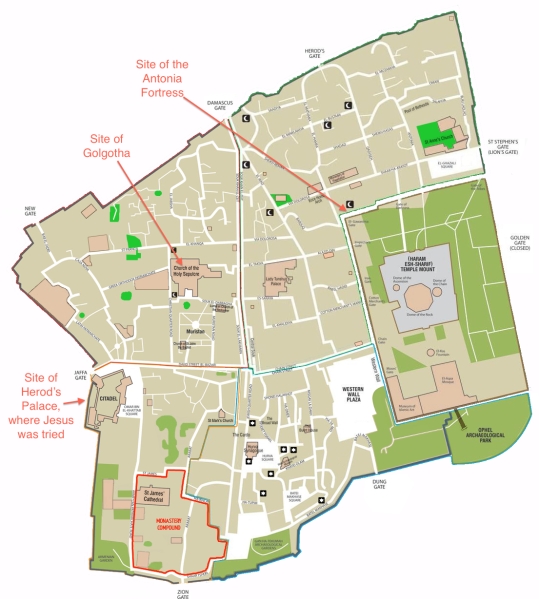The place where Pontius Pilatus tried Jesus has just become accessible to the general public.

All four Gospels agree that Jesus was tried before the Roman Prefect of Judea, Pontius Pilatus. A widely held tradition places the location of the trial at the Antonia Fortress, where the local Roman garrison was stationed. The Antonia was situated at the northwest corner of the Temple Mount. The Via Dolorosa (‘Way of Suffering’), with its stations of the cross, is said to trace the path that Jesus took from the place of his trial to the place of his execution.
Unfortunately, this path is historically improbable.
The site of Jesus’ execution—Golgotha, where the current Church of the Holy Sepulchre stands—is almost certainly correct. But the Antonia was almost certainly not the site of his trial. The current course of the Via Dolorosa, which starts at the site of the Antonia on the north side of the Old City, stems back only to medieval times. In the preceding Byzantine era, the route began at the Old City’s west.
From the writings of the late first century Jewish historian, Josephus, we know the Roman Prefects and Procurators of Judea lodged in Herod’s dazzling palace on Jerusalem’s Western Hill. So grandiose was the palace that Josephus says it surpassed every other building and had features that simply defied adequate description (Wars 5.177–81 [5.4.4]). Normally, the Roman Prefect resided at Caesarea Maritima, on the coast. But on certain occasions, like the festival of Passover, the Prefect and detachments of the Italian Legion would venture up from Caesarea Maritima to Jerusalem, with the Prefect taking up residence in Herod’s grand palace on Jerusalem’s western hill. Josephus gives an account of the final Procurator, Gessius Florus (AD 64–66), lodging in this palace and holding public court on a platform in front of it (Wars 2.301 [2.14.8]; cf. 2.328–29 [2.15.5]). This was probably ‘The Stone Pavement’ (Greek: Lithostroton; Aramaic: Gabbatha) mentioned in John 19.13.
Florus presumably followed the protocol of his predecessors, like Pontius Pilatus, Prefect from AD 26–36.
So when the Jewish authorities brought Jesus to Pilatus on that April morning in AD 33, it would have been to Herod’s Palace, since this is where the Roman Prefect conducted business.

Reconstruction of Herod’s Palace (Second Temple Model, Jerusalem)
From the palace, it was a short walk of about 400 metres to Golgotha. The fact that Jesus required the assistance of Simon of Cyrene to carry his cross this short distance speaks to the kind of condition he must have been in after the Romans had flogged him.
Thanks to Josephus’ work, the location of Herod’s grand palace has always been known. It is to the immediate south of the current Jaffa Gate on the western edge of Jerusalem’s Old City. The palace was largely destroyed in the downfall of Jerusalem in AD 70, and has since been built over. The site today is known as both ‘The Citadel’ and the ‘Tower of David’, despite having nothing to do with King David. It currently houses a museum.

View of the Tower of David on the site of Herod’s palace in Jerusalem.
Excavations to extend the museum began some fifteen years ago, but were halted numerous times. Nonetheless, the foundations of Herod’s palace now seem to have been uncovered. The Tower of David Museum is now offering tours of the ruins. So for the first time, the general public will have access to the remains of the site where Jesus was tried before Pontius Pilate.
The photo below comes courtesy of the Tower of David Museum.
The Huffington Post has more photos.
The Washington Post has more on this story.




